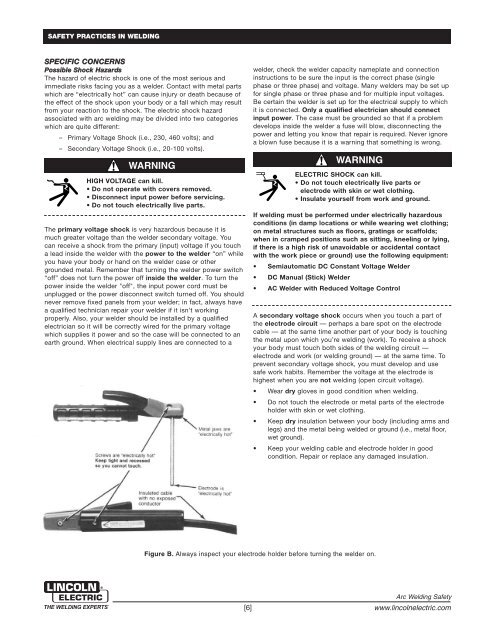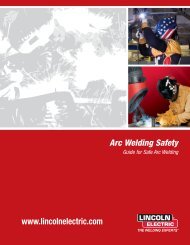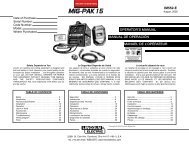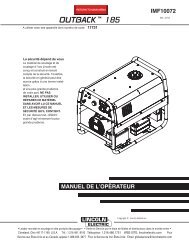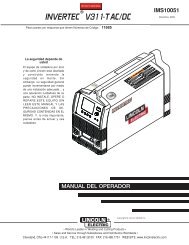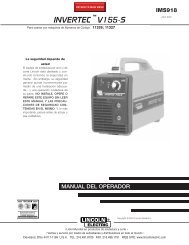E205 Arc Welding Safety - Lincoln Electric
E205 Arc Welding Safety - Lincoln Electric
E205 Arc Welding Safety - Lincoln Electric
Create successful ePaper yourself
Turn your PDF publications into a flip-book with our unique Google optimized e-Paper software.
SAFETY PRACTICES IN WELDING<br />
SPECIFIC CONCERNS<br />
Possible Shock Hazards<br />
The hazard of electric shock is one of the most serious and<br />
immediate risks facing you as a welder. Contact with metal parts<br />
which are “electrically hot” can cause injury or death because of<br />
the effect of the shock upon your body or a fall which may result<br />
from your reaction to the shock. The electric shock hazard<br />
associated with arc welding may be divided into two categories<br />
which are quite different:<br />
– Primary Voltage Shock (i.e., 230, 460 volts); and<br />
– Secondary Voltage Shock (i.e., 20-100 volts).<br />
WARNING<br />
HIGH VOLTAGE can kill.<br />
• Do not operate with covers removed.<br />
• Disconnect input power before servicing.<br />
• Do not touch electrically live parts.<br />
The primary voltage shock is very hazardous because it is<br />
much greater voltage than the welder secondary voltage. You<br />
can receive a shock from the primary (input) voltage if you touch<br />
a lead inside the welder with the power to the welder “on” while<br />
you have your body or hand on the welder case or other<br />
grounded metal. Remember that turning the welder power switch<br />
“off” does not turn the power off inside the welder. To turn the<br />
power inside the welder "off", the input power cord must be<br />
unplugged or the power disconnect switch turned off. You should<br />
never remove fixed panels from your welder; in fact, always have<br />
a qualified technician repair your welder if it isn’t working<br />
properly. Also, your welder should be installed by a qualified<br />
electrician so it will be correctly wired for the primary voltage<br />
which supplies it power and so the case will be connected to an<br />
earth ground. When electrical supply lines are connected to a<br />
[6]<br />
welder, check the welder capacity nameplate and connection<br />
instructions to be sure the input is the correct phase (single<br />
phase or three phase) and voltage. Many welders may be set up<br />
for single phase or three phase and for multiple input voltages.<br />
Be certain the welder is set up for the electrical supply to which<br />
it is connected. Only a qualified electrician should connect<br />
input power. The case must be grounded so that if a problem<br />
develops inside the welder a fuse will blow, disconnecting the<br />
power and letting you know that repair is required. Never ignore<br />
a blown fuse because it is a warning that something is wrong.<br />
WARNING<br />
ELECTRIC SHOCK can kill.<br />
• Do not touch electrically live parts or<br />
electrode with skin or wet clothing.<br />
• Insulate yourself from work and ground.<br />
If welding must be performed under electrically hazardous<br />
conditions (in damp locations or while wearing wet clothing;<br />
on metal structures such as floors, gratings or scaffolds;<br />
when in cramped positions such as sitting, kneeling or lying,<br />
if there is a high risk of unavoidable or accidental contact<br />
with the work piece or ground) use the following equipment:<br />
• Semiautomatic DC Constant Voltage Welder<br />
• DC Manual (Stick) Welder<br />
• AC Welder with Reduced Voltage Control<br />
A secondary voltage shock occurs when you touch a part of<br />
the electrode circuit — perhaps a bare spot on the electrode<br />
cable — at the same time another part of your body is touching<br />
the metal upon which you’re welding (work). To receive a shock<br />
your body must touch both sides of the welding circuit —<br />
electrode and work (or welding ground) — at the same time. To<br />
prevent secondary voltage shock, you must develop and use<br />
safe work habits. Remember the voltage at the electrode is<br />
highest when you are not welding (open circuit voltage).<br />
• Wear dry gloves in good condition when welding.<br />
• Do not touch the electrode or metal parts of the electrode<br />
holder with skin or wet clothing.<br />
• Keep dry insulation between your body (including arms and<br />
legs) and the metal being welded or ground (i.e., metal floor,<br />
wet ground).<br />
• Keep your welding cable and electrode holder in good<br />
condition. Repair or replace any damaged insulation.<br />
Figure B. Always inspect your electrode holder before turning the welder on.<br />
<strong>Arc</strong> <strong>Welding</strong> <strong>Safety</strong><br />
www.lincolnelectric.com


